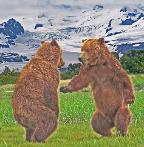|
Bear Ecology
Prey Invertebrates:
Fish: Mainly those that occur in large schools in shallow water where they can be caught by a bear. These are usually fish that Amphibia, reptiles and birds: Rarely captured by a bear. Small mammals: mostly rodents (beaver, ground squirrel, marmot, etc.) Large land mammals: eaten by both black and grizzly bears
Large marine mammals: About the only thing that polar bears eat.
For further details on bear diets, read the appendix to Beauty Within the Beast Which types of habitat are occupied by each species? Black bears: They frequent wetlands in spring to forage on succulent, protein rich greenery. As that matures it is less nutritious, so bears switch to colonial insects until fruits ripen during summer and fall. Fall is also when most nuts ripen. Black bears have been in North America over 100,000 years. They once occupied virtually all forests in North America from northern Canada sound into northern Mexico. Their short, sharp claws enable them to climb trees readily and thus to harvest nuts, fruit, new leaves and buds growing there. Trees also provide refuge from enemies. They do little digging for underground plant foods. In general, the only non-forested habitat they occupy is in the far northeast of Nova Scotia or New Brunswick – habitat that they have never had to share with any other kind of bear. Grizzly bears: did not immigrate to North America, across the Bering Land Bridge until roughly 12,000 to 14,000 years ago – about the same time that humans did. They arrived to find forests saturated with black bears. They adapted to exploit underground plant foods and rodents. Their finger claws become longer and blunter, making them more efficient as shovels. Their should muscles became much larger to power those shovels. To survive against enemies in habitat without trees to climb, grizzly bears had to be much larger than black bears. One side effect is that large body size and longer-straighter claws, reduced their ability to climb trees – especially trees without branches to use like ladder steps. Polar bears: Live mainly on sea ice. There are three kinds of sea ice:
What preys on bears?
What other enemies do bears have?
Where do bears hibernate, sleep or rest? Hibernation Dens Dug dens Black and grizzly bears
Pregnant polar bears dig dens in a snowbank, for instance on a steep slope or in a gully. Their dens seldom penetrate into the underyling soil. Cave dens: Some grizzly bears hibernate in a pre-existing cave; black bears may be less likely to do so. Tree dens: Black bears sometimes den inside a hollow tree, even if they have to climb over 50 feet up the trunk to find an opening into the tree – usually a hole where a branch had formerly grown out, but later broke off. Grizzly bears are not known to den inside trees, if only because trees large enough for a grizzly bear are virtually unavailable on grizzly bear habitat. Ground dens: Black bears are much more likely than grizzly bears to den under a pile of brush or log jam. Occasionally, an adult male black bear will simply lie down in some sheltered spot and let itself be buried in snow. This is most likely in habitat with mild winters and where wolves have long been absent. Sleeping/resting sites Storm shelter: During blizzards, polar bears may take shelter by digging into a snowbank. Seldom do black or grizzly bears seek sheltered in a cave even during a bad rainstorm. Normal ground-level day beds: Any place but a “cave” where a bear rests or sleeps on the ground is known as a day-bed. When the ground is free of snow, bears may simply lie down on the ground as it is; or they might rake away rocks and sticks, or pile up leaves and grass to make the spot more comfortable. If the bear's belly is bulging with food, it sometimes keeps weight on its belly to a minimum by digging a belly hole into which its belly can sag while the bear lies with its chest on the ground. Trees:
When do bears den?
What is hibernation? Hibernation involves slowing metabolic rate much farther than happens during sleep. Hibernating animals achieve correspondingly deeper levels of unconsciousness. That is, it takes greater degrees of disturbance to wake them up. This profound slowing of metabolic rate and deep unconsciousness is called “torpor.” Why hibernate? To avoid starvation Winter famine: During winter time when snow covers the ground, nutritious plant foods such as hard and soft mast, succulent vegetation, and underground plant foods can’t be harvested. In general, the only plant foods available are woody tissue that only a small range of species can subsist on because their guts house microbes that can break down the woody material into sugar. Bears that don’t hibernate: Subadult and adult male polar bears and females with cubs at least one year old do not hibernate. For winter is the season when their main prey are most readily available. That’s the season when polar bears fatten up. In habitats where salmon, marine carrion or other foods remain available all winter, grizzly and black bears may also not hibernate. Bears that do: However, even in habitats with abundant winter food, pregnant female bears must den up to give birth and rear cubs until the youngsters are mature enough to cope with life outside the den. So during pregnancy and the first months after birth, polar bear mothers do hibernate, much as do black and grizzly bear mothers. During periods without sufficient food, all bears hibernate or risk severe weight loss and starvation. Body fat or stored food? During weeks or months when animals can’t obtain enough food to replace the nutrients and energy that they expend, they must make up the difference with energy and nutrients that they have stored in a cache (e.g., food stored by picas or by squirrels, beaver, and some other rodents) or on their bodies, for instance as fat. Metabolic rate: The faster an animal’s metabolic rate, the more energy and nutrients it burns per hour. At high metabolic rate, stored food and fat are used up quickly. To avoid running out before spring, animals show their metabolic rate, making them more lethargic. Is the torpor of all hibernating animals equally deep? Body size: No.
Winter diet
What other differences occur between small- vs. large-bodied hibernators? Winter nutrient supply: A bear can store enough fat on its body to last it all winter – even if winter lasts up to 8 or 9 months. Rodents can only store enough fat to last a matter of weeks or days. Even those that hibernate (e.g., ground squirrels) have to wake up and eat food they have stored. Because they eat, they must also urinate and defecate during winter. Body fat: Hibernating bears live off body fat. As fat is burned, the waste products produced are just water and carbon dioxide; both carbon dioxide and water vapor are excreted through lungs as the bear exhales. The protein that breaks down in the bear’s body is regenerated, so that uric acid wastes don’t accumulate and cause acidosis. Calcium and other minerals lost from bones are recycled and re-deposited in bone so that bones stay strong – unlike what happens with bed-ridden humans. Why don’t bears store enough fat that they don’t need to hibernate?
|
| Bear Viewing Association To watch, to wonder, and to conserve [email protected] Ph/Fax (907) 260-9059 (Office) 39200 Alma Ave. Soldotna, AK 99669 |


Answers to questions commonly asked by wildlife viewers on the topics listed below: |
| Bear Viewing Association To watch, to wonder, and to conserve [email protected] Ph/Fax (907) 260-9059 (Office) 39200 Alma Ave. Soldotna, AK 99669 |

